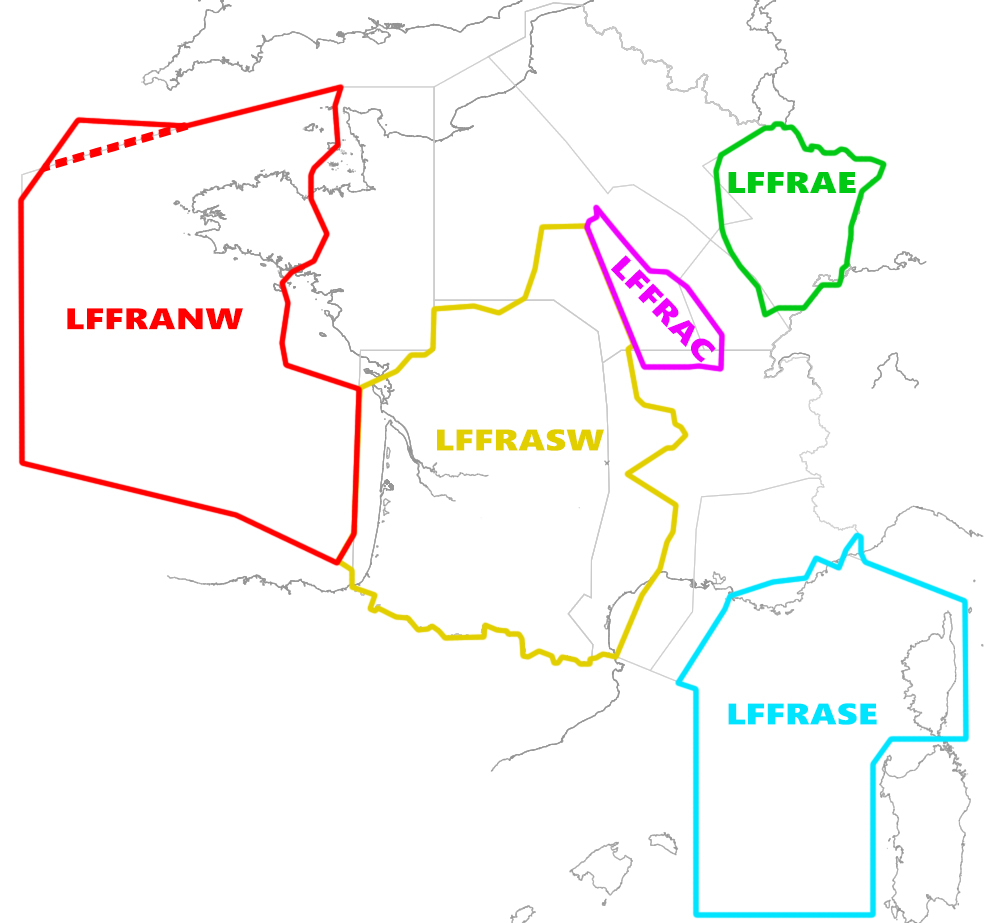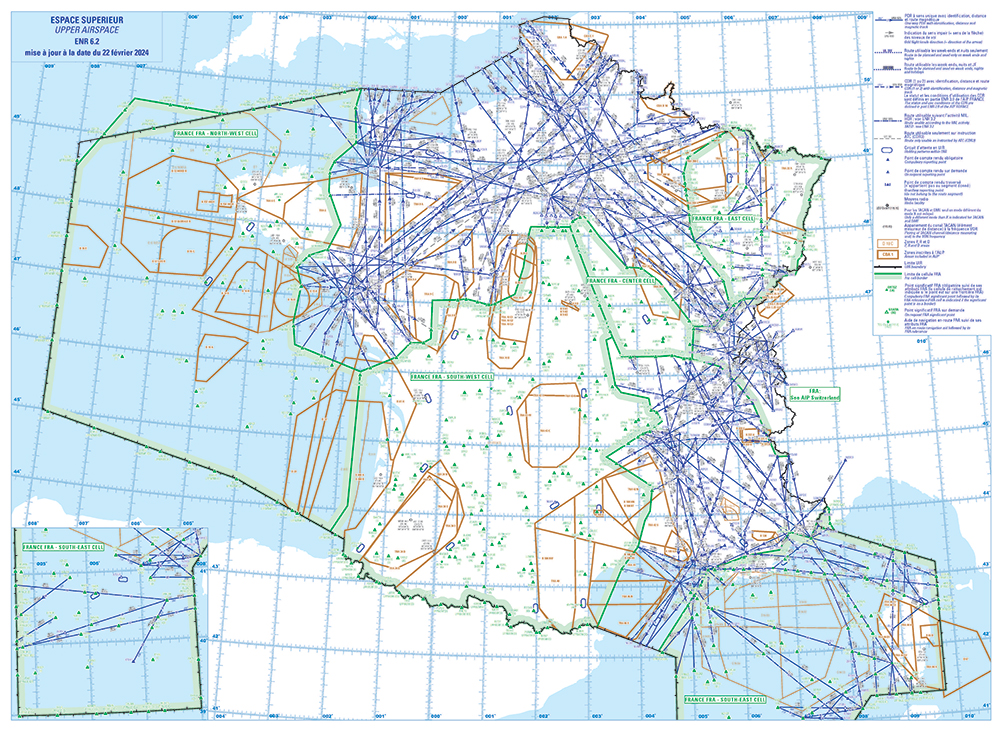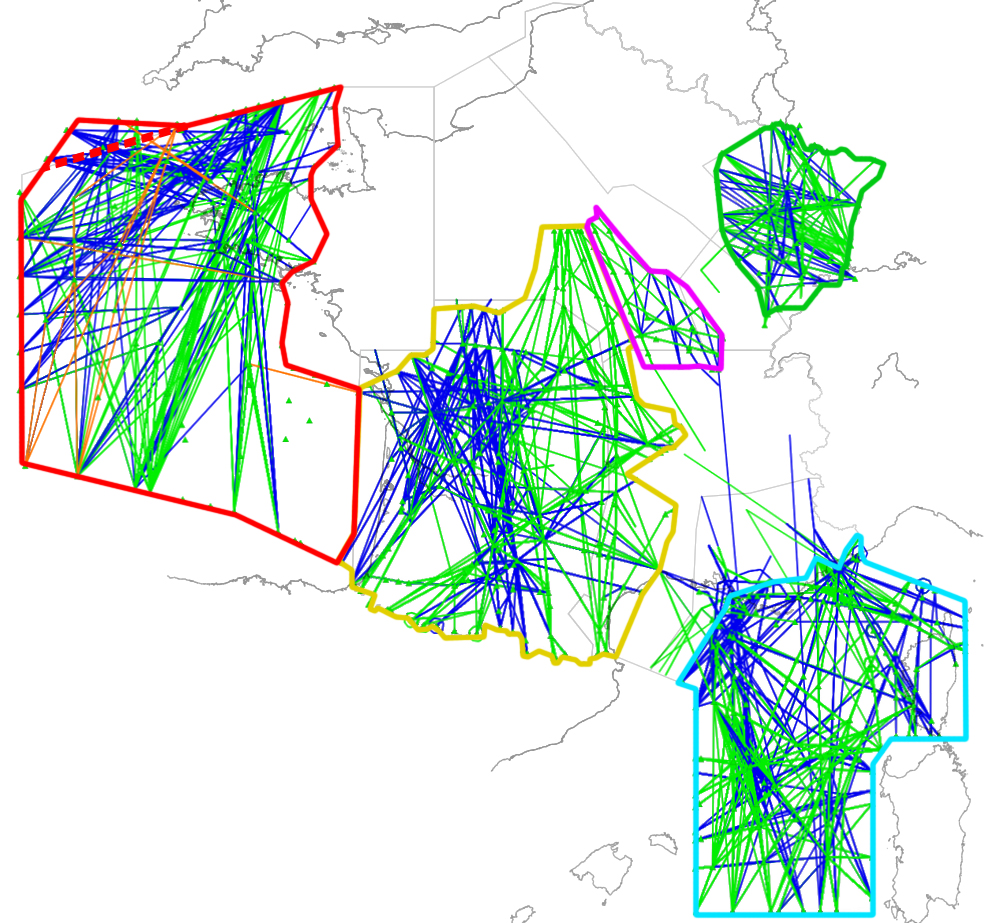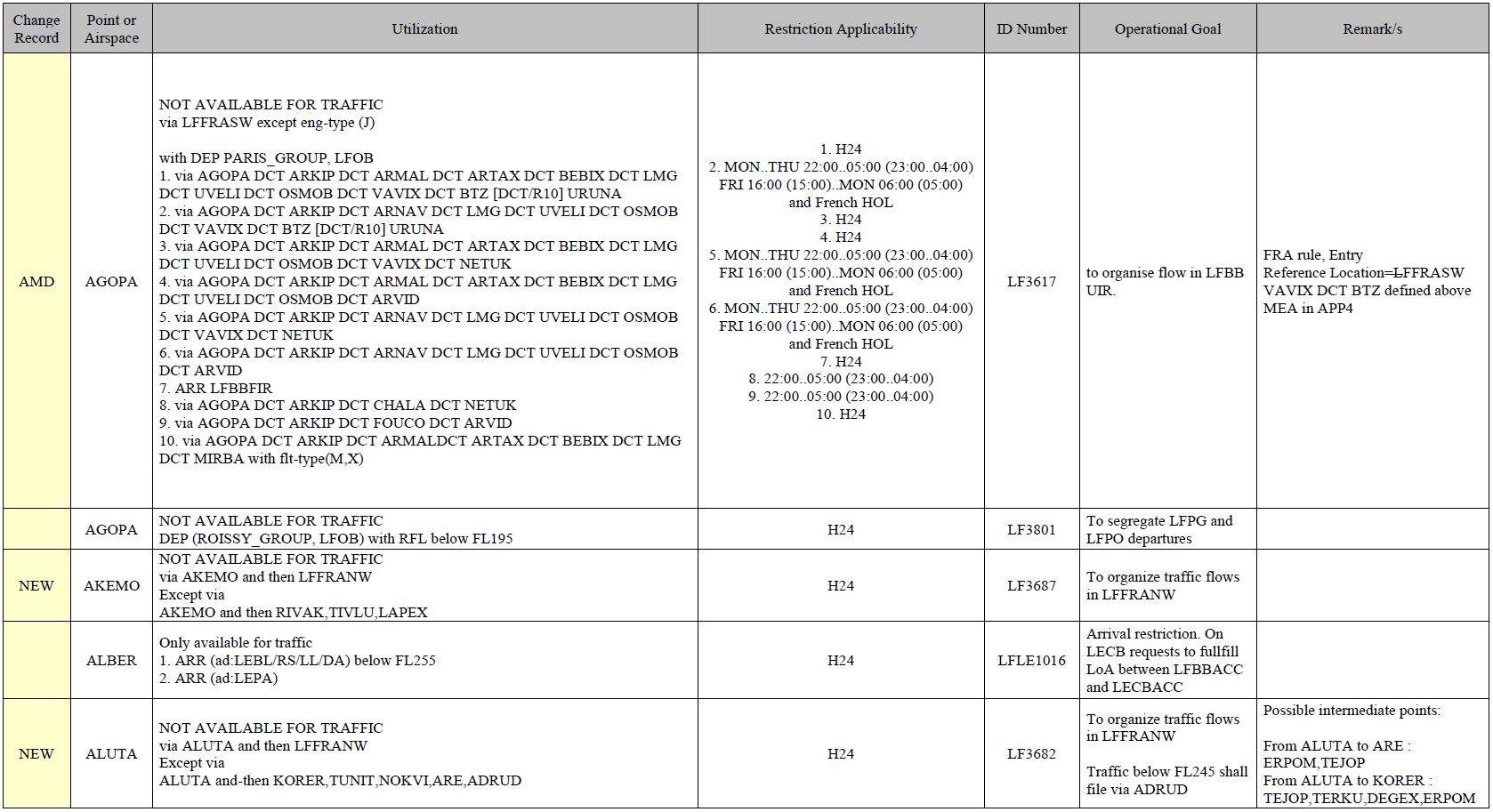The Free Route Airspace («FRA»)
This page will be evolving according the experience we will gather with time and the evolution of FRA in France.
Last update : 26/02/2024 - East and South-East FRA cell added - Global review.
1. Definitions
1.1 Free Route Airpsace («FRA»)
In the EU official documents, a Free Route Airspace is defined as such :
« Free route airspace (‘FRA’) [...] is a specified airspace within which airspace users may freely plan a route between defined entry and exit points. Subject to airspace availability, airspace users must have the possibility to choose a route via intermediate, published or unpublished, waypoints without reference to the ATS route network. Within that airspace, flights remain subject to air traffic control. »
In other words, a FRA is a piece of airspace in three dimensions (laterally and vertically bounded), within which one can freely plan its flight trajectory from an entry point to an exit point. The trajectory can use intermediate turning points. Available entry and exit points shall be published in the country AIP. In those free route airspace, former ATS routes are withdrawn.
More details on the European enforcement of these FRA and their expected benefit can be found in the Commission Implementing Regulation (EU) 2021/116.
1.2 Turning points roles
Free Route Airspace is using a subset of usual navigation points (FIX, VOR, NDB). Each point has one or more roles in regard to the Free Route Airspace, which define how plannable they are.
5 roles are defined :
- Entry point - «E» : plannable to enter the Free Route Airspace.
- Exit point - «X» : plannable to exit the Free Route Airspace.
- Intermediate point - «I» : planned usually to perform level and/or speed change in cruise.
- AD Departure connectivity point - «D» : plannable to enter a Free Route Airpsace while departing an aerodrome below or in the vicinity of the Free Route Airspace. It is often the last point of a Standard Instrument Departure (SID).
- AD Arrival connectivity point - «A» : plannable to exit a Free Route Airspace towards an aerodrome below or in the vicinity of the Free Route Airpsace. It is often the starting point of a Standard Terminal Arrival Route (STAR).
Those roles are defined within french AIP, ENR 4.1 and ENR 4.4 - "Remarks" column - sections. They are printed as well on the Upper Airspace chart in the ENR 6.2 section.
To access french AIP, click on the link available in right menu of this page, and navigate to "AIP" > "eAIP France".

1.3 Typical trajectories within a FRA
As previously stated, ATS routes do not exist anymore within FRA - with some exceptions. As such, flight planning is only possible using "DCT" links between the aforementioned turning points.
Inside a given Free Route Airspace, the flight trajectory will match one of the following scenarios :
- Overflight : E => I* => X
- Flight from outside the FRA, towards an aerodrome below or in the vicinity of the FRA : E => I* => A
- Flight from an aerodrome below or in the vicinity of the FRA towards outside the FRA : D => I* => X
- Flight between two aerodromes below or in the vicinity of the FRA : D => I* => A
* Number of intermediate turning points is ranging from 0 to many. This depends on the pilot's choice as well as flight level changes.
Take note that ideally, a pilot can plan its trajectory freely within a FRA. However restrictions can apply regarding mandatory points to plan. Those restrictions are mainly defined in the RAD (Route Availability Document) published by Eurocontrol. This document is updated each AIRAC cycle. Within french FRA, you will mostly be forced to plan some specific intermediate points, to better organize traffic flows within the airspace.
The Initial Flight plan Processing System - IFPS - from Eurocontrol checks and validates flight plan within the Eurocontrol area in Europe. This tool will help you to verify if your planned trajectory is compliant with the restrictions in the RAD. Indeed, the RAD itself is quite a complex document hardly readable by humans as it is more and more intended to be processed by software.
To access IFPS, click the link in the right menu of this page. Once on the NOP web-page, navigate bottom of the right column. Click on "Free Text Editor" or "Structured Editor" from the "Flight Planning" section. You will then access to the flight plan validator.
2. FRA in France
FRA initial application in France is described in AIC n°11/21, published by SIA. FRA extension is described in AIC n°14/23.
2.1 Free Route Airspace cells within french UIR
From the 2nd of December 2021, three distinct Free Route Airspace are in force in France.
- LFFRASW : South-West FRA, which the CRNA (Centre Régional de la Navigation Aérienne - ACC) Sud-Ouest, in Bordeaux, is responsible for
- LFFRAC : Center FRA, which the CRNA Nord, in Athis-Mons (Paris), is responsible for
- LFFRANW : North-West FRA, which the CRNA Ouest, in Brest, is responsible for
Since the 22nd of February 2024, two additionnal Free Route Airspace cells are added.
- LFFRAE : East FRA, which the CRNA Est, in Reims, is responsible for
- LFFRASE : South-East FRA, which the CRNA Sud, in Aix-en-Provence, is responsible for
Those five airspace are defined from FL195 to FL660.
As shown in the picture below, those 5 airspace are spread within all metropolitan FIR and ACC - Bordeaux (LFBB), Brest (LFRR), Paris (LFFF), Reims (LFEE) and Marseilles (LFMM).

Slight subtle detail, LFFRANW airspace is split into two parts (dashed line on the picture). The north-west one has its floor set at FL245 and not FL195, to account for interface with the English lower airspace and airspace delegations.
Almost all upper ATS routes (FL195/FL660) have been withdrawn within the french Free Route Airspace - except for some remaining airways in the North-West, East and South-East FRA. The Upper Airspace chart from french AIP clearly depicts the new situation.

2.2 Flight trajectories within french FRA
In some countries with Free Route Airspace, planning a flight within their FRA is almost really free. In France however, planning a flight through the FRA is subject to many constraints, mainly due to military airspace, ATC sectorisation, etc. Simply speaking, french FRA are using the "White List" principle. One cannot fly into french FRA except by flying along prescribed trajectories, defined in the RAD.
A few details on the 3 french airspace :
- LFFRANW : It is mainly defined above the Atlantic ocean. Constraints on the plannable trajectories are almost non-existing. Majority of plannable trajectories are simply linking a entry point "E" to an exit point "X" (for overflights). Intermediate points are mostly used for level change.
- LFFRASW : It is probably the most complex FRA of the three. There is a lot of aerodrome connectivity and military areas to account for. Globally most of the plannable trajectories are following the shape of the former ATS routes, still allowing some corner cuts when available.
- LFFRAC : It is a very tiny airspace, and highly constrained. Plannable trajectories are exactly those from the former ATS routes.
- LFFRASE : Most of the cell is located over Mediterranean sea. The main use case of this cell is for transit flights, and the planification is rather simple like it is for the LFFRANW cell.
- LFFRAE : This cell is quite small, thus the planification is not that easy. However, this cell allows for cross-border planification with Switzerland and German FRA cells. This possibility eases somehow the planification of flights in this cell.
Here is a visual representation of all plannable trajectories within the french FRA, as of the 22nd of February 2024 :

Blue trajectories are those with an even flight level (mainly northbound), while the green trajectories are using odd flight level (mainly southbound).
It is important to note that semi-circular rule applies within french FRA. In France UIR, northbound trajectories shall mainly use an even flight level, and southbound trajectories shall mainly use an odd flight level. The details of level parity are located in the ENR 1.3.9.2.4 section of the french AIP.
FABEC (Functional Airspace Block Europe Central) of which France is member, did a statistic study on the expected FRA benefits for air traffic. Based on a typical day of 2019 traffic (pre-COVID), cumulative gain in terms of flown distance is estimated at :
- LFFRANW : 3600 NM
- LFFRASW : 1800 NM
- LFFRAC : 0 NM
2.3 RAD - The key to plan your flight in french FRA
In theory, planning a flight in a Free Route Airspace is quite simple. In France however, airspace complexity makes this truth wrong and sets some restrictions on flight planning.
Those restrictions are defined in the RAD.
Without going too deep inside RAD details, RAD is a complex document listing all European restrictions on flight planning. For FRA flight planning, two parts of the RAD are of interest.
A) Annex 2B « Local and Cross-border Capacity and Structural Rules »
Local and Cross-border Capacity and Structural Rules Annex describes with which sequence of turning points a FRA can be planned.

Yet, all available direct routing are not listed in this annex. Appendix 3B lists as well potential directs applicable in Europe. However, for french FRA, appendix 3B is of limited use.
B) Annex 3A « Aerodrome Connectivity Options »
This annex lists all restrictions regarding airport connectivity. Among others restrictions, it describes how to join airports that are below or in the vicinity of Free Route Airspace to/from these Free Route Airspace. This is done using the Departure (D) and Arrival (A) connectivity points.

You will probably need other parts of the RAD as well to fully plan your flight. Hopefully, IFPS gives most of the time comprehensive errors pointing to specific restrictions within RAD to help you fix your trajectory!
3. Examples of FRA valid routing
You will find hereafter some routes samples covering the different cases we mentioned above. For each example route, the FRA section of the trajectory is written in bold. Each point and its role are then detailed.
3.1 Departing from an AD covered by a FRA
Brest - Paris Orly
LFRB ROSPO DCT KORER UN482 NIMER LFPO
FRA points :
- ROSPO (D) : LFRB Departure point (LFFRANW)
- KORER (X) : FRA (LFFRANW) eXit point
Toulouse - Paris Orly
LFBO FISTO DCT PERIG DCT DIBAG DCT TUDRA DCT BEVOL UT158 AMB LFPO
FRA points :
- FISTO (D) : LFBO Departure point (LFFRASW)
- PERIG (I) : Mandatory intermediate point
- DIBAG (I) : Mandatory intermediate point
- TUDRA (I) : Mandatory intermediate point
- BEVOL (X) : FRA (LFFRASW) eXit point
3.2 Arriving to an AD covered by a FRA
Lyon - Brest
LFLL BELEP UP860 TIS DCT VALKU DCT PECNO DCT LMG DCT MANAK UT183 TIRAV UN490 TERPO UM616 KORER DCT ARE LFRB
FRA points :
- TIS (E) : FRA (LFFRASW) Entry point
- VALKU (I) : Mandatory intermediate point
- PECNO (I) : Mandatory intermediate point
- LMG (I) : Mandatory intermediate point
- MANAK (X) : FRA (LFFRASW) eXit point
- KORER (E) : FRA (LFFRANW) Entry point
- ARE (A) : LFRB Arrival point (LFFRANW)
Paris CDG - Bordeaux
LFPG AGOPA DCT ARKIP DCT ARMAL DCT ARTAX DCT BEBIX DCT LMG LFBD
FRA points :
- AGOPA (D) : LFPG Departure point (LFFRASW)
- ARKIP (I) : Mandatory intermediate point
- ARMAL (I) : Mandatory intermediate point
- ARTAX (I) : Mandatory intermediate point
- BEBIX (I) : Mandatory intermediate point
- LMG (A) : LFBD Arrival point (LFFRASW)
